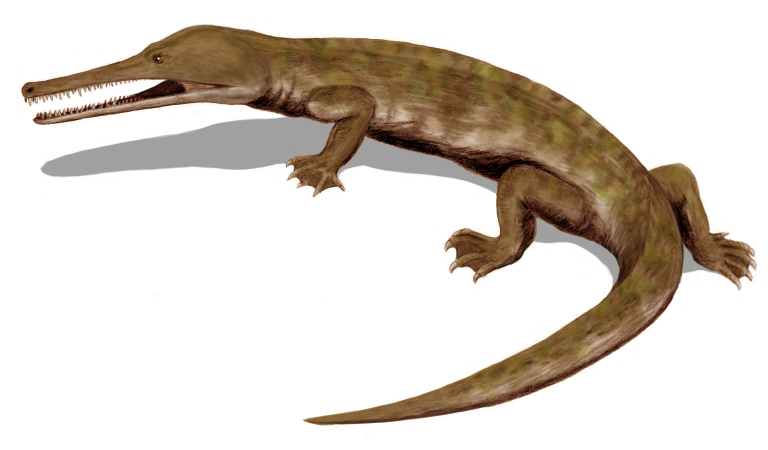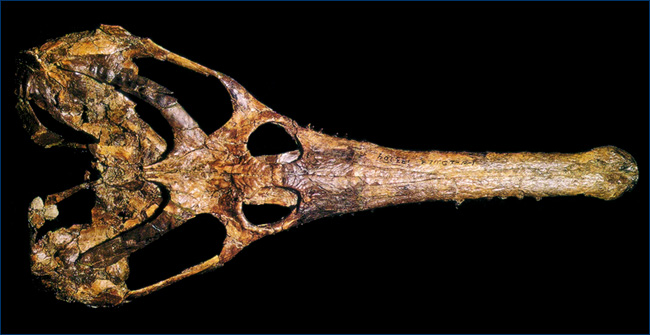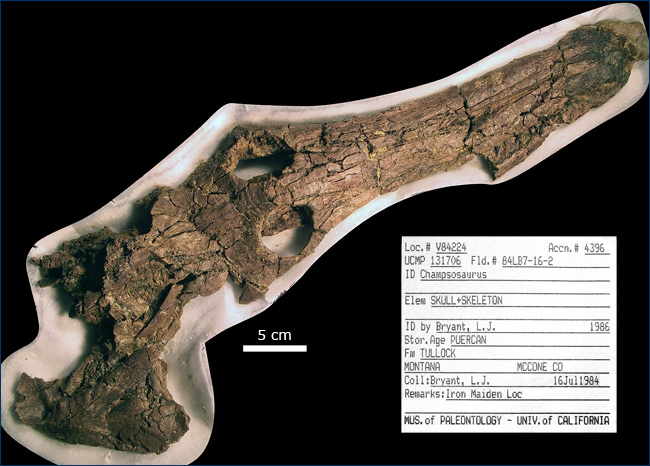[Recent Entries][Archive][Friends][User Info]
November 4th, 2013
| November 4th, 2013 | |
|---|---|
| 07:24 pm [industrialterro] [Link] |
Champsosaurus Хампсозавры (Champsosaurus) — род вымерших рептилий группы диапсид отряда Choristodera. В длину хампсозавр был примерно 1,5 метра, хотя C. gigas, самый крупный вид рода, достигал длины 3—3,5 м. Считается, что хампсозавр внешне напоминал гавиала и, подобно гавиалу, охотился в реках и болотах, ловя рыбу своими длинными челюстями с большим количеством зубов. Он, вероятно, плавал с помощью боковых движений тела, зафиксировав свои конечности возле туловища с целью увеличения своей подвижности, как современные крокодилы и морские игуаны. Мышцы челюстей хампсозавра были очень широкими и мощными. Ископаемые останки хампсозавров были найдены в Северной Америке (Альберта, Саскачеван, Монтана, Нью-Мексико, Техас, Вайоминг) и Европе (Бельгия и Франция), в отложениях, начиная с верхнего мела и до середины эоцена. Его название означает «ящерокрокодил»; корень «Champso-» был взят из утверждений древнегреческих авторов, что «египтяне называют крокодилов χαμψαι [champsae]». Choristodera is an order of semi-aquatic diapsid reptiles which ranged from the Middle Jurassic, or possibly Late Triassic, to at least the early Miocene. Choristoderes have been found in North America, Asia, and Europe. The most common fossils are typically found from the Late Cretaceous to the lower Eocene. Cladists have placed them between basal diapsids and basal archosauromorphs but the phylogenetic position of Choristodera is still uncertain. It has also been proposed that they represent basal lepidosauromorphs. Most recently, workers have placed Choristodera within Archosauromorpha. Champsosauridae is the best-known family of the Choristodera and typifies the group. Champsosaurus was first described from Late Cretaceous strata of Montana by Cope in 1876. Champsosaurs resembled modern gharials (gavials) or false gharials. The skull of these animals have a long, thin snout filled with small, sharp conical teeth. This is due to champsosaurs and gharials occupying similar niches: hunting small aquatic prey in rivers and swamps. This is a classic example of convergent evolution. More primitive choristoderes have shorter, broader snouts. There are major differences seen between choristoderes and gharials and other crocodilians, however, particularly in the skull. The orbits are found well forward on the skull, and the rear of the skull is bulbous, hugely expanded and consists of complex bony arches surrounding empty space. These spaces probably contained massive jaw muscles. Other hypotheses for the spaces, such as an otic sensory organ housing, have been tossed around with little support. The external nares are found on the tip of the rostrum. This indicates that champsosaurs breathed while submerged by extending their rostrum through the water surface while their body rested on the bed of the lake or stream. Crocodylians and phytosaurs have their nares located dorsally on their rostrum or skull respectively. This position allows them to rest submerged just below the surface. Champsosaur skulls are actually very similar to lizard skulls, though heavily modified. This has led some researchers to consider champsosaurids as lepidosauromorphs. However, champsosaurs lack the complex quadrate of lepidosaurians. With features of both diapsid groups, the phylogenetic position of Choristodera is highly confused. Other features found in choristoderes include heavily ossified gastralia and modified distal limbs, not just the manus and pes, used as paddles. In addition, champsosaur ribs are short and massive, as in other aquatic reptiles. The thorax is dorso-ventrally flattened, and the tail is laterally compressed to aid in swimming. Skin impressions found with champsosaur fossils show non-overlapping scales of very small size and the skin containing no scutes like those found in crocodilians (see crocodile exoskeleton).
Ископаемые останки и реплики (1, 2, 3, 4, 5, 6):
Tags: Вымершие рептилии, Мел, диапсиды, хористодеры |
| Time | Event |
| 08:16 pm [industrialterro] [Link] |
Hyphalosaurus Hyphalosaurus (meaning "submerged lizard") is a genus of freshwater aquatic reptiles which represent a major part of the Jehol Biota. They lived during the early Cretaceous period (Aptian age), about 122 million years ago. The genus contains two species, H. lingyuanensis and H. baitaigouensis, both from the Yixian Formation of Liaoning Province, China. They are among the best-known animals from the Jehol Biota, with thousands of fossil specimens representing all growth stages in scientific and private collections. Hyphalosaurus fossils are relatively widespread in the Jehol beds, which represent a series of freshwater lakes. Several specimens of H. lingyuanensis and thousands of H. baitaigouensis specimens are known from the Yixian Formation, including entire growth series from embryos in eggs to fully grown adults. H. baitaigouensis was originally reported from the younger Jiufotang Formation, though subsequent study showed that the fossil beds it was found in probably also belong to the Yixian, though from younger rocks and a different region than H. lingyuanensis. H. lingyuanensis and H. baitaigouensis were largely similar in anatomy, both achieved a maximum adult body size of about 0.8 meters. They had small heads with numerous needle-like teeth, and extremely long tails with more than 55 vertebrae. The primary difference between the two species is the number of vertebrae in the neck. H. lingyuanensis had 19 neck vertebrae, while H. baitaigouensis had 26. Two specimens of Hyphalosaurus have been described with clear impressions of the skin. One specimen represents H. lingyuanensis, and the other (with clearer impressions) cannot be assigned to a species because part of the neck (the length of which is a key indicator of species) was destroyed when fossil dealers grafted a skull from a different specimen onto the slab. However, both specimens show nearly identical patterns of scales. Hyphalosaurus was covered mostly in small, irregularly patterned polygonal scales, though these varied across the body. The scales of the hind legs were smaller, finer and more irregular than those of the torso, while the scales of the tail were nearly square and arranged in more regular rows. In addition to the small scales, two rows of large, round scutes with shallow keels ran along the animals sides. One row ran directly along the flank, with the other either slightly higher or lower and composed of scutes only 1/4 the size of the flank scutes. The flank row of larger scutes extended all the way to the base of the tail, and remained uniform in size across the entire row. The tail itself has preserved soft tissue extending well beyond the margins of the skeleton. This, combined with the already flattened appearance of the tail vertebrae, suggests that a ridge of skin may have extended from the top and bottom of the tail creating a small fin. The feet and hands also appear to have been webbed. ( Read more )
Размеры тела в сравнении с человеком:
Ископаемые останки (1, 2, 3, 4, 5, 6, 7, 8):
( Read More ) Tags: Вымершие рептилии, Мел, диапсиды, хористодеры |
| Previous Day | 2013/11/04 [Archive] |
Next Day |


















